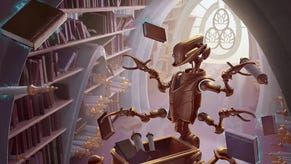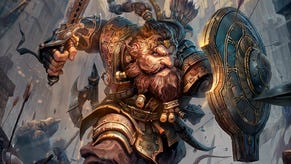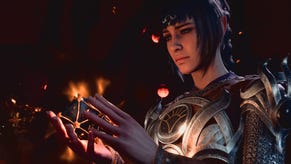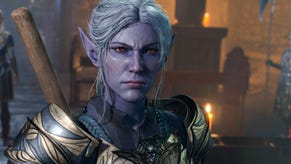“Diverse voices make characters come alive”: Anansi’s Tapestry of Lives creator on making D&D 5E NPCs more inclusive
Written by Eberron and Forgotten Realms designers.
Anansi’s Tapestry of Lives is a supplement for Dungeons & Dragons 5E, and other tabletop roleplaying games, that provides game masters with around 100 non-player characters to put into their games. Rarely featured in major rulebooks and adventure books released for D&D 5E – unless they’re major characters – non-player characters, or NPCs, are characters that are controlled by the GM rather than the players. Whilst some NPCs get characterisation in RPGs, the GM is often left with the task of coming up with minor characters in the moment – which can be incredibly stressful.
The NPCs featured in Anansi’s have been written by a diverse creative team, many of whom are notable members of the tabletop RPG community, with the emphasis on offering GMs a large cast of characters to include in their campaigns and/or one-shot sessions that aren’t all just white, heterosexual, cisgender and able-bodied.
We spoke with Jamie Van Doren, founder of Neverending Inc and the mastermind behind Anansi’s Tapestry of Lives, about the upcoming supplement – what GMs and players can expect, why its mission for diversity is important and what other studios could be doing to make the tabletop roleplaying community a more inclusive space.
In your own words, what is Anansi’s Tapestry of Lives?
Jamie Van Doren: Anansi's tapestry of lives actually started out as a much smaller project. We were originally writing all of the NPCs in-house with a couple of guest writers. It was based off the character art from our character builder. As we started talking with more people about it, we started getting more interest from outside writers. That then evolved into this ginormous book of over 100 NPCs, which is paired with professionally voice-acted monologues.
Well over 70% of our contributors are BIPOC - black indigenous people of colour, LGBTQ+ and/or disabled. It's important because I'm marginalised: I'm mixed race, latino and gay. The opportunity to have a really fantastic and useful supplement for game master, has turned into a platform for inclusion and representation - which is great, because it means that even if you don't have a lot of diversity at your table, but can still have that authentic diversity and representation in your game world.
It's always the throwaway NPCs that the players become enamoured with.
Why is having a cast of well written NPCs important to an RPG campaign?
When we're playing D&D, we want a level of immersion and engagement in our game worlds. So having these non-player characters that have a personality and a backstory brings a richness to that game world. And it does so in a way that doesn't exhaust the dungeon master. The DM is already having to come up with the entire game world and play the full cast of characters. Which is hard enough. This is a way for people to bring authenticity to their game, without a tonne of prep. And all of our NPCs are background characters for the most part. They're like the blacksmith, the stable-hand and the tavern server. These are the characters that the core rulebooks often don't cover. This fills in those blanks.

What does Anansi’s bring to a campaign that core TRPG rulebooks don’t?
When Wizards of the Coast [publisher of Dungeons & Dragons] or another company comes out with an adventure book, they put some of the most important NPCs in there. 10, 15 and maybe even 20 named NPCs. But when you're going to these different locations, there are hundreds of people that players are interacting with. However, it's always the throwaway NPCs that the players become enamoured with. You do quick description of the local stable-hand and all of a sudden, they want to know everything about the stable-hand but that person isn't in the rulebook. In Anansi’s Tapestry of Lives gives you that character with their full personality, an intro monologue, a backstory, quirks and a driving goal.
We are limited by our own life experiences and by the things that we have experienced directly, which means our NPCs and our game worlds are fundamentally limited.
Do you have any examples of any that you particularly like?
There are over 100 NPCs written by a wide-array of TTRPG writers, including Jim Zub, Keith Baker, Ed Greenwood, Jasmine Bhullar, Tanya Depass and Jennifer Kretchmer. In terms of characters, there’s this tiefling that you might encounter out in the wilds called Auspice. She's really incredibly well written by Cassandra McDonald, who is a trans woman. There's some beautiful things that come across with this character. When the players are kind of lost in the wilderness, and they need a safe place for a short rest, they might stumble across the Last Light Waystation, which is this abandoned abbey that she's taking care of. There's also a couple of different blacksmiths - one of my favourites is Belram Wildboot, who's this dwarf who is a blacksmith and a baker. He's kind of the adoptive father of all these street kids and is really sweet.
How does having a more diverse cast of non-player characters make for a better world and campaign?
We are limited by our own life experiences and by the things that we have experienced directly, which means our NPCs and our game worlds are fundamentally limited. But when you bring in all of these diverse voices, people who have different backgrounds and life experiences, they bring those into their characters. One of our writers Glaiza Champion is Filipino and they wrote a fantastic 13-year-old diver based off their own culture. I could have written a diving character and they might have been okay. But what they bring to that character is attitude of the 13-year-old and the understanding of what it takes to be a diver. It makes that character come alive. He's so much more interesting and real than anything that I could have written, because he's based on their knowledge and experiences with that culture.
I still wondered - do I belong here? When everybody else around the table to my eyes looks the same.
When I was growing up, tabletop games were both an escape for me: a place of acceptance and a place of worry. I didn't see other people like me with my background around the table, I was the only Latino and the only one that I knew that was gay. I was the only person having come from poverty and who was still living in poverty. I was able to explore different aspects of my personality, my identity, at the table. But I still wondered - do I belong here? When everybody else around the table to my eyes looks the same. Their experiences are all similar, so you feel left out. If you see other characters in the game world that look like you – you think “oh, maybe I do belong in this world.” That fear can evaporate and you can just have this uninhibited enjoyment. It’s easy for us to change that reality by providing this fantastic book so that there is the opportunity for you to see someone like you in the world that you're playing in.
How else do you think could diversity and inclusion be improved in the D&D community and industry?
One of the things that we've done with this project is that we've made sure to make a space for more people of colour, LGBTQ folks and disabled folks. I think it's critical. Many companies are doing better about increasing diversity and representation, with Wizards of the Coast’s Journeys to the Radiant Citadel being a great example of that all. That's one step though.
It's especially critical for us to make these diverse characters more visible because as they're more visible, they're more accepted.
We have to deliberately make space for minority and marginalised voices. That's one of the reasons why I'm so excited that we have folks like comic book writer Jim Zub, Eberron creator Keith Baker, Forgotten Realms creator Ed Greenwood, and ex-Cleveland Browns' pro-football Johnny Stanton on board, alongside and many other big names. These folks recognise that having these larger platforms are also a way for them to create space for these other writers who might not have an opportunity to be on a big book like this. If you think about how few BIPOC, LGBTQ or disabled writers have the chance to have their name in the credits next to Jim Zub, Ed Greenwood and Keith Baker.
We won't see more diversity and representation until people who have these platforms also work to uplift these voices and create spaces for them to shine.

What do you think Dungeons & Dragons’ creator Wizards of the Coast specifically could do to improve diversity?
I'm feeling good about Wizards trying to make changes with removing stats attached to species and moving towards backgrounds. I think one of the most challenging things that we see is the fact that ‘races’ is just a loaded term. We don't use the term ‘races’ because it is so fraught. Throughout the history of D&D, especially in the early days, there was a correlation between fantasy races and actual cultures. It’s a minefield, so they have to be extra sensitive to how this information is getting presented, because it can either break down tropes and stereotypes or it can reinforce those tropes and stereotypes. There's still a lot of work to be done, but I'm hopeful that they're putting the effort in. I do think it's better for them to just rip off the band aid, just make these changes. They’ve flirted with including more representation of disability as well.
People will complain because it's new and novel. It's not what they're used to and it conflicts with their preconceived notions. Which why it's especially critical for us to make these diverse characters more visible because as they're more visible, they're more accepted. It becomes easier for people to let go of their preconceived notions and their stereotypes to gain new knowledge.
The Kickstarter campaign for Anansi’s Tapestry of Lives is live until October 27th, with a pledge of $60 (£54) getting backers a hardcover copy of the book in May 2023. Alternatively, a digital PDF version is available for a pledge of $32 (£29).










